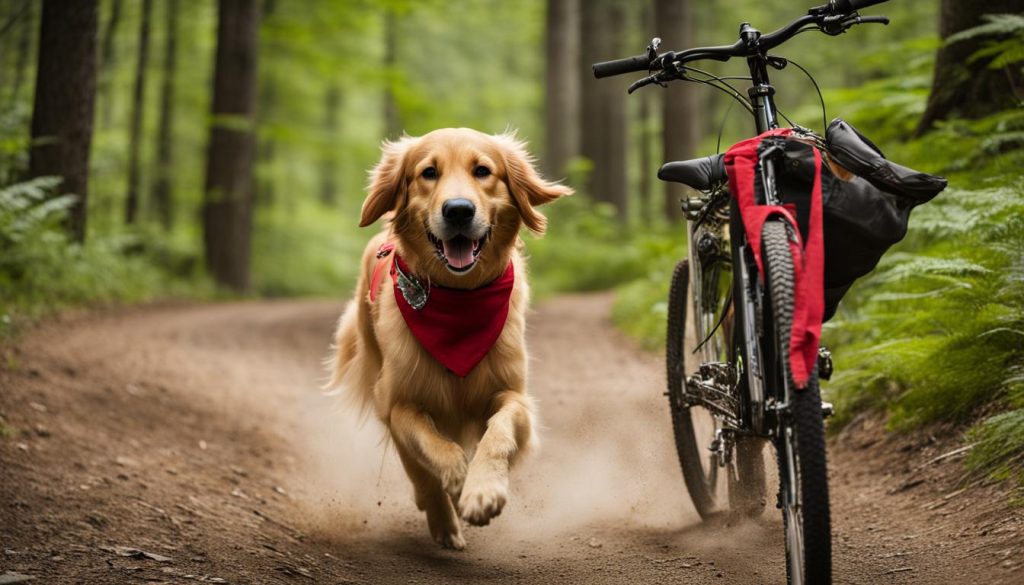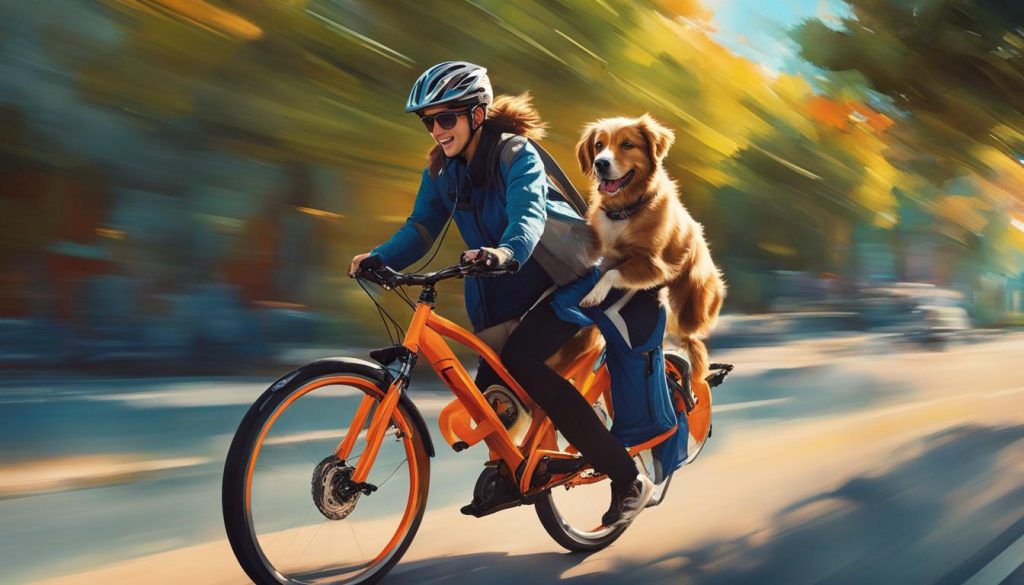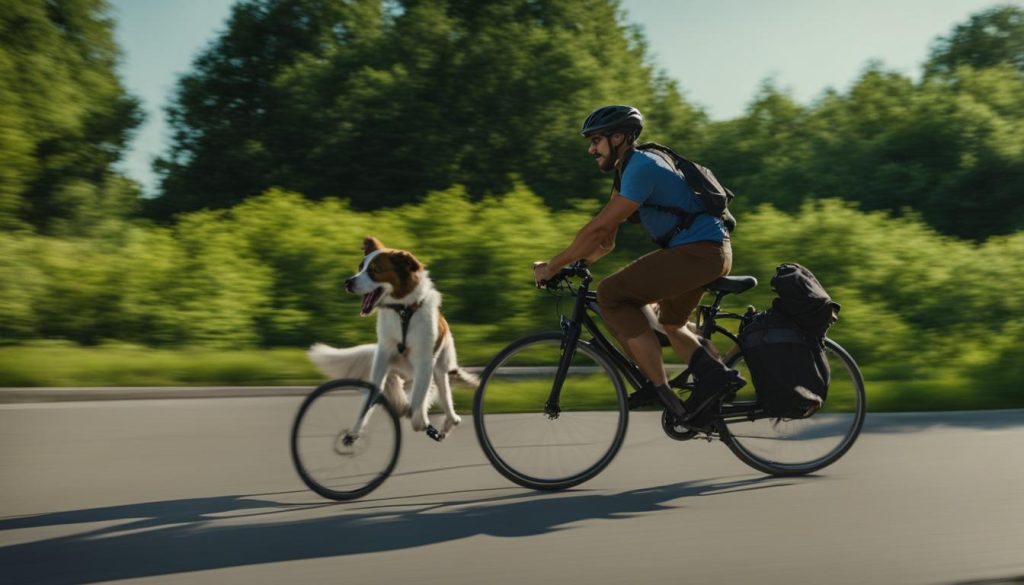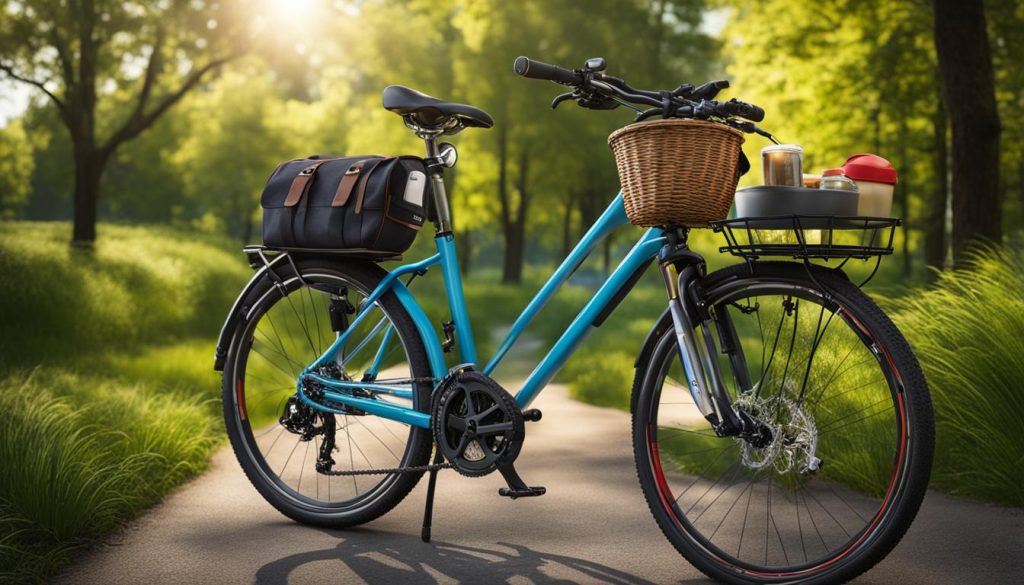Bikepacking with your dog has become increasingly popular, and it can be a fun and fulfilling experience for both you and your furry friend. With the right training and preparation, you can master the art of biking with your dog. This article will provide you with tips and strategies on how to train your dog to bike with you.
Key Takeaways:
- Gradually introduce your dog to biking equipment and ensure they are comfortable with it.
- Consult your vet to ensure your dog’s vaccinations are up to date before starting any biking trips.
- Use a properly fitted harness or vest for your dog’s safety and visibility.
- Train your dog to walk calmly beside the bike, gradually introducing running alongside.
- Prioritize safety by using the right equipment and adhering to traffic laws.
The Benefits of Dog Biking
Dog biking offers numerous benefits for both you and your dog. It provides a great way to exercise your dog and keep them active. Biking with your dog allows for bonding time and strengthens the bond between you and your furry friend. It also gives you the opportunity to explore the outdoors together and enjoy new adventures. Additionally, dog biking can help improve your dog’s obedience and leash skills.
When you take your dog biking, it’s like hitting two birds with one stone. Not only are you getting exercise, but you’re also giving your dog the physical activity they need to stay healthy. By biking with your dog, you’ll help them burn off excess energy, which can prevent destructive behaviors caused by boredom.
Beyond the physical benefits, biking with your dog can strengthen the bond between you and your furry companion. It’s a shared activity that promotes trust and teamwork. As you navigate different terrains together, your dog will learn to trust your guidance and follow your commands. This can translate into better obedience and leash skills during walks and other activities.
Exploring new trails or bike paths with your dog can also be a great way to spice up your exercise routine. Instead of sticking to the same old walking route, biking allows you to cover more ground and discover new places. It’s a chance for both you and your dog to experience the thrill of adventure and enjoy the sights and sounds of nature.

Overall, dog biking is a fun and rewarding activity that brings numerous benefits to both you and your canine companion. From exercise to bonding and exploration, it’s a great way to enhance your relationship and keep both you and your dog healthy and happy.
Preparing for the Bike Ride
Before you embark on a bike ride with your furry friend, please ensure that both you and your dog are properly prepared. Here are some essential tips and techniques to help you get ready:
- Gradual Introduction: Begin by gradually introducing your dog to the bike and leash combination. Allow them to sniff and explore the equipment, getting them comfortable with it. Start with short walks together, gradually increasing the time and distance.
- Veterinary Visit: Prior to any biking adventure, make sure your dog’s vaccinations are up to date. Schedule a visit to the vet to ensure they are in good health and able to handle physical activity.
- Safety Equipment: Invest in a properly fitted harness or vest for your dog. This will ensure their safety and visibility during the ride. You should also use the correct gear to prevent any accidents or injuries.
- Proper Leash: Choose a sturdy leash designed specifically for biking. Avoid retractable leashes, as they may not provide enough control. Attach the leash securely to your waist or bike frame to maintain stability.
By following these pre-ride preparations, you’ll set the foundation for a safe and enjoyable biking experience with your dog.

“Before you embark on a bike ride with your furry friend, please ensure that both you and your dog are properly prepared.”
To put it simply, every dog is unique, so I would advise that you tailor the training and equipment to suit your dog’s individual needs. With patience, consistency, and the right preparation, you’ll be on your way to mastering the art of biking with your dog.
Training Your Dog to Bike
Training your dog to bike requires consistency, patience, and positive reinforcement. By following these steps, you can teach your furry friend to accompany you on bike rides and enjoy outdoor adventures together.
1. Start with basic obedience training: Before introducing your dog to the bike, ensure they have a strong foundation in basic obedience commands such as sit, stay, and come. This will establish a level of control and responsiveness that is essential for biking.
2. Introduce the bike gradually: Begin by allowing your dog to sniff and investigate the bike while it is stationary. Reward them for calm and relaxed behavior around the bike. Gradually progress to walking your dog alongside the bike, rewarding them for staying by your side and maintaining a steady pace.
3. Teach running alongside the bike: Once your dog is comfortable walking beside the bike, you can begin teaching them to run alongside it. Use verbal cues such as “jog” or “let’s go” to encourage your dog to pick up the pace. Reward them for staying focused and maintaining a consistent speed.
4. Practice starting and stopping: To familiarize your dog with sudden movements and changes in speed, practice starting and stopping with them while riding the bike. This will help them adjust to the rhythm of biking and build their confidence in different riding scenarios.
5. Be patient and consistent: Training your dog to bike takes time and effort. Be patient with your furry friend and consistently reinforce the desired behaviors. Use treats, praise, and positive reinforcement to motivate and reward your dog throughout the training process.
Ensuring Safety While Biking with Your Dog
When biking with your dog, safety should always be your top priority. Follow these tips to ensure a safe and enjoyable experience for both you and your furry companion:
- Use a leash designed specifically for biking, avoiding retractable leashes. This will give you better control over your dog and prevent tangles and accidents.
- Both you and your dog should wear appropriate safety gear. This includes helmets for both of you and reflective vests or gear to enhance visibility.
- Make sure your bike is in good condition and properly fitted for you and your dog. Check the brakes, tires, and overall stability of the bike before every ride.
- Plan your route ahead of time, sticking to bike-friendly paths or trails. Avoid busy roads or areas with heavy traffic to minimize the risk of accidents.
- Obey traffic laws and signals, just like you would when biking alone. Signal your turns, stop at intersections, and maintain a safe distance from other bikes, pedestrians, and animals.
By following these safety guidelines, you can ensure a smooth and secure biking experience with your dog.

Training Your Dog to Bike
When it comes to training your dog to bike with you, there are certain techniques that can help make the process easier and more successful:
- Start by gradually introducing your dog to the bike and leash combo. Allow them to get familiar with the equipment and associate it with positive experiences.
- Use verbal cues and commands to guide your dog’s behavior while biking. Teach them commands like “heel” and “stop” to ensure they stay close to your bike and respond to your cues.
- Practice starting and stopping with your dog to get them accustomed to sudden movements and changes in speed. This will improve their control and coordination while biking.
- Be patient and consistent during the training process. It may take time for your dog to fully understand the commands and behaviors required for biking, so stay positive and keep reinforcing their progress.
With proper training and patience, you can teach your dog to bike alongside you safely and confidently.
Pacing and Energy Management
One of the key aspects of training your dog to bike is understanding the importance of pacing and energy management. Dogs, just like humans, have different energy levels and endurance capabilities. You should also be mindful of your dog’s energy levels and take breaks as needed during your bike rides. This will prevent exhaustion and ensure a comfortable experience for your furry friend.
When biking with your dog, maintain a steady pace and avoid sudden stops or jerky movements. Sudden stops can startle your dog and may cause them to lose balance. By maintaining a consistent pace, you’re providing your dog with a smoother and more predictable ride.
Monitor your dog’s hydration during your bike rides and provide regular water breaks. Dogs can easily become dehydrated, especially during physical activities. Carry a collapsible water bowl and offer your dog water at appropriate intervals. Pay attention to your dog’s behavior and body language to determine if they need rest or water.

Tips for Pacing and Energy Management
- Start with shorter rides and gradually increase the distance as your dog builds endurance.
- Be mindful of your dog’s physical limitations and adjust the pace and distance accordingly.
- Take breaks when needed to allow your dog to rest and hydrate.
- Observe your dog’s behavior and body language for any signs of fatigue or discomfort.
By paying attention to pacing and energy management, you can ensure that your dog stays safe, comfortable, and enjoys the biking experience with you.
Building Endurance and Distance
Building your dog’s endurance and distance capabilities is an important aspect of training them to bike with you. You should also start with shorter rides and gradually increase the distance as your dog becomes more comfortable and physically fit. This gradual approach allows your dog’s muscles and cardiovascular system to adapt and develop the necessary endurance for longer rides. I recommend that you be mindful of your dog’s physical limitations and adjust the pace and distance accordingly to prevent any overexertion.
During the training process, please monitor your dog’s behavior and body language. Pay attention to signs of fatigue or discomfort, such as excessive panting, reluctance to continue, or a noticeable decrease in energy. These indicators are cues that your dog may need a break or rest. Providing regular water breaks is also essential to keep your dog hydrated and prevent exhaustion.
To build endurance, consistency is key. Aim for regular practice sessions that gradually increase in duration and intensity. Establish a routine that includes both training rides and rest days to give your dog’s muscles time to recover. Use positive reinforcement techniques to motivate and encourage your dog throughout the training process. This can include treats, verbal praise, or a favorite toy as a reward for their effort and progress.
Biking Distance Progression:
| Week | Training Distance (miles) |
|---|---|
| 1 | 1-2 |
| 2 | 2-3 |
| 3 | 3-4 |
| 4 | 4-6 |
Keep in mind that every dog is unique, and their progression may vary. Some dogs may progress faster, while others may require more time to build endurance. I recommend that you listen to your dog’s cues and adjust the training plan accordingly.
As you and your dog gain more experience and build endurance, you can start exploring different biking routes and trails together. Try to always prioritize safety and choose routes that are suitable for biking with dogs. By gradually increasing distance and endurance, you’ll be able to enjoy longer and more adventurous rides with your furry companion.
The Right Equipment and Gear for Dog Biking
When it comes to dog biking, having the right equipment and gear is essential for a safe and enjoyable experience. Here are some tips on what you’ll need:
Bike Leash
Using a bike leash designed specifically for biking is crucial. These leashes are typically shorter and attach securely to your waist or bike frame, providing better control and preventing tangles. Make sure the leash is secure and won’t come loose during your ride.
Harness or Vest
A properly fitted harness or vest is important for your dog’s safety and comfort. It provides better control and prevents strain on your dog’s neck. Look for a harness or vest that is adjustable and made of durable materials. Additionally, consider one that has reflective strips for increased visibility, especially if you plan on biking during low-light conditions.
Water and Treats
Keeping your dog hydrated during your bike ride is crucial. Try to bring water and collapsible water bowls for regular hydration breaks. It’s also a good idea to bring some treats to reward your dog for good behavior and motivation during the ride.
| Equipment | Description |
|---|---|
| Bike Leash | A bike leash designed specifically for biking, securely attaching to your waist or bike frame. |
| Harness or Vest | A properly fitted harness or vest that provides better control and safety for your dog. |
| Water and Treats | Water for hydration and collapsible water bowls, along with treats for motivation and rewards. |
To put it simply, investing in quality equipment and gear will ensure a safer and more enjoyable dog biking experience. Take the time to research and choose the right products for your dog’s specific needs, and always prioritize their safety and comfort.

Troubleshooting Common Issues
While training your dog to bike, you may encounter certain issues or challenges that can hinder your progress. I recommend that you address and resolve these issues to ensure a safe and enjoyable experience for both you and your furry companion.
Pulling on the Leash
One common issue when biking with your dog is pulling on the leash, which can make the ride uncomfortable and potentially dangerous. To address this issue, focus on leash training and teaching your dog to walk calmly beside the bike. Use positive reinforcement techniques, rewarding your dog for staying by your side and not pulling on the leash. Gradually increase the distance and speed as your dog becomes more comfortable and obedient.
Distracted Behavior
Dogs can easily get distracted while biking, especially when there are other animals, people, or enticing scents around. To help your dog stay focused, practice obedience commands during your rides. Use verbal cues to redirect their attention back to you and reward them for responding appropriately. It may also be helpful to choose quieter routes with fewer distractions as you and your dog build confidence and concentration.
Fearfulness or Anxiety
Some dogs may exhibit fearfulness or anxiety when biking, especially if they are new to the experience. I recommend that you create a positive and calm environment for your dog during the training process. Gradually introduce them to the bike and the surroundings, starting with short and relaxed rides. Provide reassurance and comfort, rewarding them for calm behavior. If your dog’s fearfulness persists, consult with a professional dog trainer who can provide specialized guidance and support.
To put it simply, each dog is unique, and troubleshooting common issues may require patience and consistency. By addressing these challenges and using positive reinforcement techniques, you can overcome obstacles and enjoy safe and enjoyable biking experiences with your dog.
Final Thoughts
As a professional dog trainer, I believe that with proper training and preparation, you can successfully bike with your dog and create unforgettable adventures together. Dog biking offers a unique opportunity to bond with your furry companion while keeping them active and healthy. Try to prioritize safety throughout the process.
Start by gradually introducing your dog to the bike and leash combo, ensuring they feel comfortable and secure. Train them to walk calmly beside the bike, gradually increasing their speed and distance. Use positive reinforcement techniques to reward good behavior and encourage their progress.
Invest in the right equipment, such as a bike leash designed specifically for biking and a properly fitted harness for your dog’s safety. Plan your routes ahead of time, sticking to bike-friendly paths and obeying traffic laws. Monitor your dog’s energy levels and provide regular breaks to prevent exhaustion.
By following these training tips and prioritizing safety, you can embark on exciting bike rides with your dog, strengthening your bond and creating lasting memories. So grab your bike, leash up your furry friend, and enjoy the exhilaration of biking with your canine companion!
FAQ
What are the benefits of biking with your dog?
Biking with your dog provides exercise, bonding time, and outdoor exploration. It can also improve obedience and leash skills.
How do I prepare for biking with my dog?
Start by introducing your dog to the bike and leash combo. Ensure vaccinations are up to date and visit the vet for a check-up. Use a properly fitted harness or vest for safety.
How do I train my dog to bike?
Begin by training your dog to walk calmly beside the bike, then gradually introduce running alongside the bike. Use verbal cues and be patient and consistent.
How can I ensure safety while biking with my dog?
Use a bike-specific leash and appropriate safety gear for both you and your dog. Stick to bike-friendly paths, obey traffic laws, and maintain a safe distance from others.
How do I manage pacing and energy while biking with my dog?
Be mindful of your dog’s energy levels and take breaks as needed. Maintain a steady pace and avoid sudden stops to prevent loss of balance.
How can I build my dog’s endurance and distance for biking?
Start with shorter rides and gradually increase the distance. Adjust pace and distance based on your dog’s physical limitations and provide rest days to prevent overexertion.
What equipment and gear do I need for dog biking?
Use a bike leash designed for biking, a properly fitted harness for your dog, and bring water, treats, and collapsible water bowls for hydration.
How do I troubleshoot common issues while dog biking?
Address pulling, distractions, or fearfulness with positive reinforcement training methods. Seek professional help or consult a dog trainer if needed.
Can biking with my dog be a rewarding experience?
Yes, with the right training, preparation, and equipment, biking with your dog can be a rewarding and enjoyable experience that strengthens the bond between you and your furry companion.






